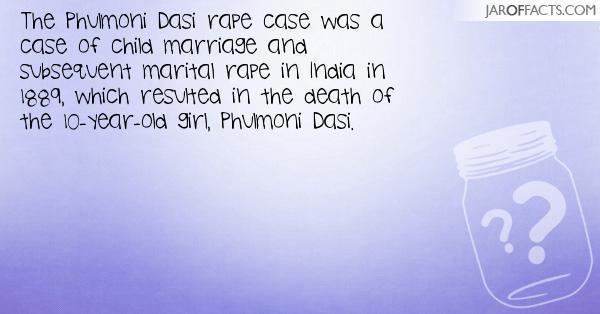Location India | ||
 | ||
Similar Ruchika Girhotra case, 2014 Birbhum gang rape case, 2013 Kamduni gang rape and murder case | ||
The Phulmoni Dasi rape case was a case of child marriage and subsequent marital rape in India in 1889, which resulted in the death of the 10-year-old girl, Phulmoni Dasi. The case led to the conviction of the husband in 1890 and triggered several legal reforms.
Contents
Events

Phulmoni Dasi was a ten-year-old Bengali girl with a 30-year-old husband named Hari Mohan Maiti. She died after having sexual intercourse with her husband.
Trial
The case went to trial in the Calcutta Sessions Court on 6 July 1890. The girl's mother provided testimony against the husband. The husband was convicted under Section 338 of the Indian Penal Code for "causing grievous hurt by act endangering life or personal safety of others". Under an exception clause in Section 375 of the Indian Penal Code, introduced in 1860, sex with one's own wife was not considered as rape. As Phulmoni was of legal age and married to Maiti, he was sentenced to 12 months of hard labor. The case is known as Empress v. Hari Mohan Maiti.
Reforms
On 9 January 1891, the Viceroy of India, Lord Lansdowne presented a bill before the Council of India, which was then headed by Andrew Scoble, called the "Age of Consent". It sought to amend Section 376 of the Indian Penal Code. Previously, the age of consent had been set at 10 in 1860. After the bill was passed on 29 March 1891, the Section 376 included sex with a girl under 12 even if the person is the wife of the perpetrator, as rape.
